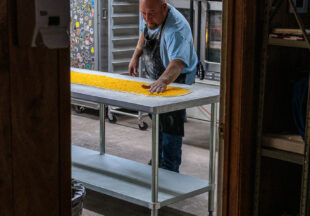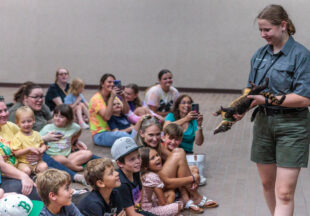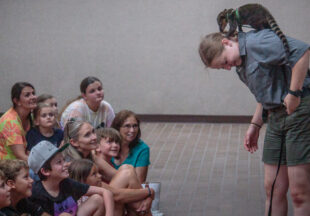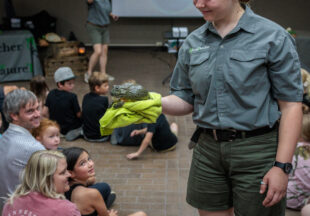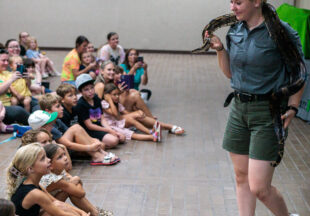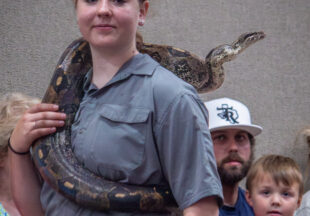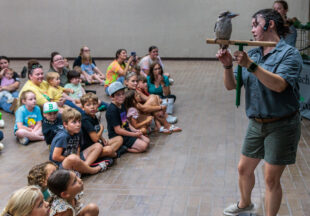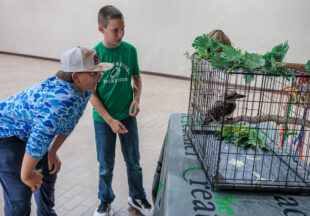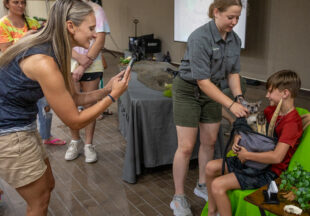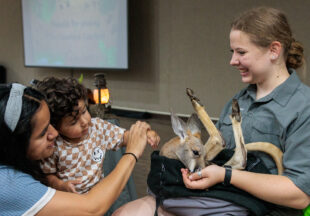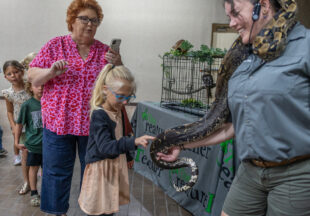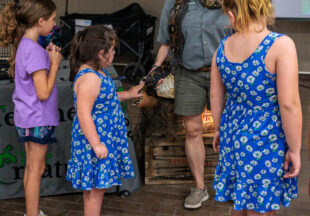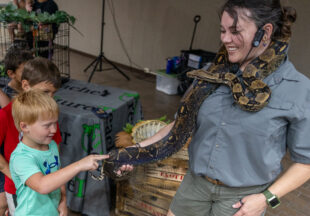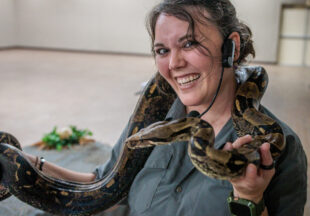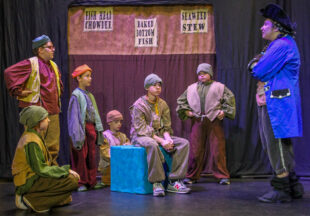Training prepares local citizens to survive active shooter event
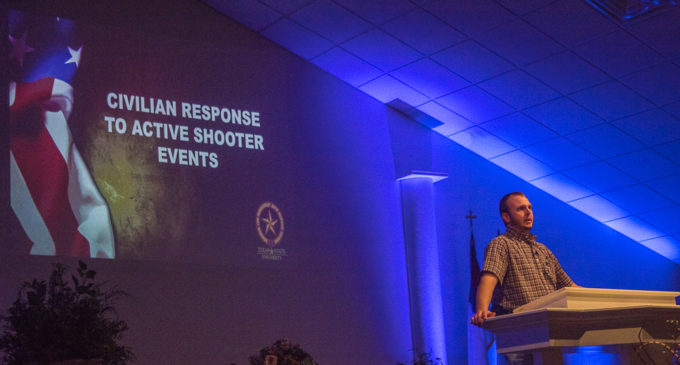
The sound of gunshots shattered the silent sanctuary of Breckenridge’s Lighthouse Church Tuesday night, and though many may have been startled by the methodical “bang, bang, bang,” no one tried to flee because they were there specifically for Active Shooter Training.
Even the presenter, Stephens County Chief Deputy Kevin Roach, admitted the loud gunshots on the video he was showing were scary. It was all part of the program to help attendees prepare for disaster response, specifically, how to prepare for and respond to being trapped inside a building during an active shooter event.
The presentation, which lasted a little more than an hour, is based on a course that Roach and Stephens County Sheriff Will Holt took from Abilene Police Chief Stan Standridge and developed by Texas State University for civilian groups, schools, businesses and civic and religious organizations.
The two officers attended a “train the trainer” course specifically so that they could come back to Breckenridge and train the local citizens here how to have a better chance at surviving an active shooter event. So far, they have presented the training at three churches, and they are currently scheduled to provide the training to the school district staff and more churches. Additionally, a community-wide presentation may be scheduled soon.
Local groups, businesses, organizations, churches, etc. can request the training at no cost to the organization.
At the beginning of the program this week, Roach informed the more than 50 people attending, “The goal at the end of the day is that if our community suffers some horrible incident, you can improve the chance of survival of you and your family.”
One of the concepts that the training is based on is that the average response time for police to arrive on the scene of an event is three minutes but that a lot can happen in those three minutes. Over the years, experts have realized that there are some effective steps citizens can take on their own, before law enforcement help arrives, to increase their chances of survival.
Roach listed off three actions people in such a situation should try to take: Avoid, Deny, Defend.
The first option is to avoid the shooter by leaving the area. Run for the nearest exit, climb out a window, do anything you can to escape, he said.
If escaping isn’t an option, try to deny the shooter access to your location. If you are in a room with a door, shut and lock or barricade the door, turn out the lights and position yourself along the wall that the door is on, so that the shooter is less likely to see you if he or she can look into the room.
If the shooter still manages to get into your location, defend yourself with whatever you can find. Roach reminded the audience that that situation isn’t the time to try and “fight fair.”
“Fight for your life. It’s not a fair fight. Use improvised weapons, gouge their eyes, bite, kick, pull, stab with scissors, throw hot coffee, hit with fire extinguishers…fight, fight, fight. It’s not fair. You must defend yourself or you will die. And, you have the legal right to defend yourself,” he said.
The gunshots on the video rang out during a portion of the presentation in which Roach was explaining some stages people tend to go through in the case of an emergency. The first phase often is denial. People tend to refuse to believe that there could be someone shooting a gun at their workplace, school, church or other public place, so their minds come up with other answers, such as the noise must be fireworks or something falling.
“If you hear gunshots or something that could be gunshots, it’s not fireworks, folks,” Roach said. “How often have you heard fireworks at work? Never.”
To increase your chance of survival, you have to quickly move past denial into the deliberation stage. But, that needs to be quick, too, he said. Deliberate quickly about what you should do and then take decisive action – avoid, deny or defend.
Some strategies that do not appear to be very successful in improving chances of survival, based on past incidents, include playing dead and “hide and hope.”
“’Hide and hope’ is not an effective strategy because what you are hiding in or under probably is not bullet proof, and once you’re found, you’re trapped,” Roach said.
One of the most effective steps anyone can take to improve their chances of survival in an emergency situation is to pre-plan their response. Think through possible scenarios and the appropriate response to those scenarios to prepare scripts that your brain will then access if you find yourself in that situation.
“’Mental scripting’ helps more than you know,” he said. “You have to preplan, so that you don’t have to process what you’re going to do. It will save your life.”
Another point Roach made was that if you ever find yourself in a situation like that, once the police arrive, everyone, including the innocent bystanders and victims, needs to follow the officers’ orders. The police usually arrive to a very chaotic scene and don’t know exactly what’s going on, he explained.
“When (the police) come in, do what they tell you to do. If they tell you to show your hands, show your hands. If they tell you to get on the ground, get on the ground,” he said. “Have your hands empty; show your hands. Do what the police tell you to do.”
At Tuesday night’s presentation, the audience was composed of a variety of local citizens, including emergency responders, school district personnel, and concerned citizens wanting information about how to survive an active shooter situation. Several families with children attended.
Following the presentation, one of the attendees, Kim Fuller, a local mother, Girl Scout leader and president of the PTO, wrote about the experience on Facebook.
“I attended an Active Shooter Workshop tonight. I took the kids with me. In today’s reality, it’s most likely going to be something they would have to face before I would, as it seems these mass shootings are happening more often at schools or events where (children) are involved,” Fuller wrote. “Actual videos of past situations were shown, but it was age-appropriate for my kiddos. Especially since we’ve been discussing possible situations that could occur at their schools. It also helped them understand why they have had to add lockdown drills to their standard fire and tornado drills without being graphic.”
Tim Seymore, superintendent of Breckenridge Independent School District, said the same training – but more school-specific – will be provided to BISD staff and faculty. Some video training will be offered immediately, and more in-depth training will be provided when the staff returns for the fall semester.
The school district has some security measures already in place, including surveillance cameras, drills and response plans, and administrators are looking to further improve the security of the schools. The district’s security measures will be assessed next week so that an updated plan can be created.
“Do we have a response right now? Yes, we have something we will do right now. Are we hoping to do more? Yes, we are hoping to do more,” Seymore said. “We are actively looking at upgrading the surveillances on all the campuses and looking at some access controls at the campuses, as well.”
Although this article covers some of the ideas and strategies offered by the training, attending an actual training session will be much more thorough and effective. To find out when a presentation that you can attend will be offered or to arrange for a training presentation to be given for an organization or business, call the Stephens County Sheriff’s Office’s non-emergency number, 254-559-2481 or visit the office in the Law Enforcement Center at 210 E. Dyer St.
Story by Carla McKeown and Tony Pilkington
Cutline, top photo: Stephens County Chief Deputy Kevin Roach presents an Active Shooter Training program at the Lighthouse Church in Breckenridge earlier this week. The Sheriff’s Office will provide the training at no cost to local organizations and business, on request. (Photo by Tony Pilkington)













